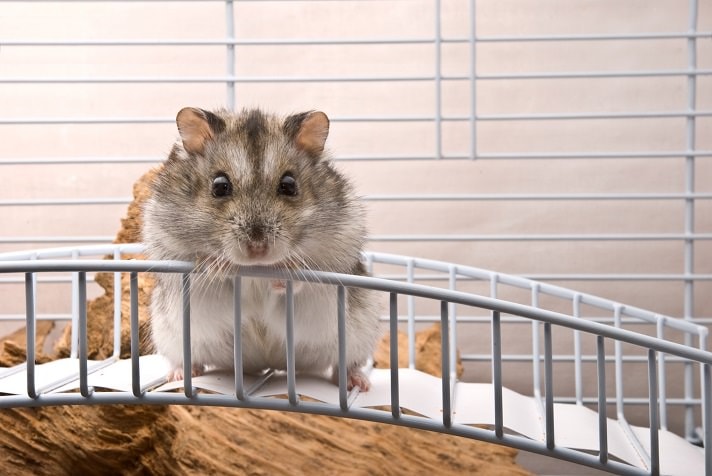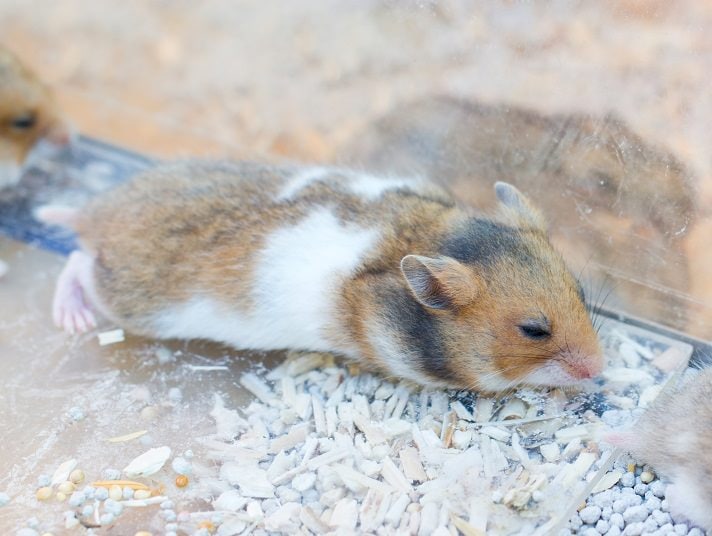Q:
My hamster escaped into a hole in my counter. I can hear him in the wall, but am concerned that he might get lost. What is the best way to lure him back out? Will he naturally return to his cage at night and come out?
A:
Unfortunately, this situation is as frightening and frustrating as it is common. Hamsters wander off and get lost all too easily. But though they rarely return to their cages immediately and without guidance, you shouldn’t become discouraged. Over the years we’ve heard stories of hamsters missing for as long as two weeks before showing up, hungry and disheveled, and completely ready to be pampered and doted over once again. Using the methods that follow the chances are good that you will bring your hamster home safely.
It’s a mystery why hamsters become lost so easily, as they have many of the same basic faculties, such as the ability to follow a scent with great accuracy, as other rodents. But somehow while rats and mice enjoy a reputation for staying within a fairly circumscribed area and making their way back home with alacrity, once hamsters depart slightly from their familiar surroundings they inevitably become distracted and wander aimlessly.
Fortunately, a hamster’s talented nose also offers the best means for luring him back. The most common method for doing this is usually referred to as the “bucket method.” There are endless variations on it, but using the basic concept you can vary the process with the easiest means at hand. The technique works as follows.
Place a bucket or deep container from which a hamster cannot escape on the floor (not too deep — you’ll see why — just deep enough that so the hamster can’t climb out). Put a variety of tasty hamster foods in the bottom. Stack books like a staircase next to the bucket. Put treats, such as a few raisins or sunflower seeds on the “steps” as well. The hamster should climb up the books, fall into the bucket (that’s why it shouldn’t be too deep) and remain there until morning (most hamsters follow the instinct to forage for food at night, so that’s when you’re likely to meet with success). If possible, put out several of these buckets.
There’s a related procedure that is also very easy. Time is of the essence of course, so combining these methods and doing everything you can is an appropriate response. The secondary procedure involves plastic bags, such as those from the grocery store — the slightly rigid, crinkly kind work best. Place these in various strategic areas around the home, and put small dishes in the middle of them containing fruits, nuts, sunflower seeds, granola, and other aromatic treats (dishes of water will attract a thirsty hamster as well).
Again, hamsters instinctually go looking for food at night, so after dusk keep listening for the rustling and crinkling of the bags. This isn’t a method for capturing the pet, but it will give you the confidence of knowing he’s still around, and at least taking some nourishment. You may find droppings and seed husks in the morning. Because hamsters tend to follow regular patterns of behavior,you may be able to determine a pattern of movement that will help you find the pet next time he goes out to dinner.
Here’s another trick that’s very effective, particularly if the missing hamster is a male. If you’ve got a female hamster in the house, or know someone with one, get hold of some of her nesting material, the stuff she sleeps in. Tissues that bear the scent of a female will get the boys running, believe me. This is a powerful instinctual drive. It’s how desert species survive, in fact! In addition to nesting material, a bit of litter that’s been soiled can work in conjunction with the bucket or the crinkly bags. When you’ve got a male on the loose and a female whose scent can serve as bait, it truly works like a charm! But this can help return a female as well. You can’t discount their natural curiosity. The lingering scent of another hamster is very stimulating, and will tend to draw them out of hiding. This may be because they’re going to be uneasy about predators in strange surroundings, but if they smell other hamsters they get the sense that the potential for danger is low, and may feel bolder about presenting themselves in the open.
As I say, the bucket method will vary according to the means at hand and where you expect the hamster to wander. The photo shows a crude bucket system created by someone who, admittedly, was not looking to find a lost pet, but to get rid of an unwanted roommate who’d arrived from out of doors. He didn’t want to hurt the visitor, so I advised putting a few inches of soft litter in the bottom of the bucket in this case. The little one was found in a day, munching happily on the peanut butter at the bottom of the bucket, and taken out to a field. I recount this because, though it’s crude, and hamsters tend to stay low and not climb on counters, the simple physics in this ingenious set-up shows the concept in a way that’s easy to improvise upon.
Once your hamster is safe and the emergency has passed, it’s worth taking a moment to review the importance of securing your hamster’s cage or other dwelling. Cages come in all shapes and sizes so there’s no single method for securing doorways. Don’t rely on an ordinary latch to stay closed, but always add an extra strong clip or clamp, easily obtained from most hardware stores, to hold it shut. Many pet stores also sell clips for this purpose. Similarly, strong clips can be purchased to hold an aquarium tank’s wire mesh lid to its body. In the case of a glass tank, if nothing else, a heavy weight, such as a brick, can be placed on top, as long as it doesn’t reduce the amount of air surface too much. If you use one of the cage systems that involve plastic tubes, secure them with tape, as these tubes are notorious for becoming detached from the cage body (helped by the hamster’s persistent nudging at it).
This is really common sense advice, but know that hamsters will surprise you! They pack a lot of burst power into their compact bodies, especially when they’re young and full of energy. They can lift a drop-down door or hefty wire mesh lid with nothing but “nose power.” They’ll climb up a water bottle in a flash. Wandering is what they do by instinct. It’s not a comment on the good care you’re trying to give them. It’s just something you must be aware they’ll attempt, and safeguard their dwelling against it. Likewise, when playing with them in the open, be sure that you can reach the nearest hole in the wall or crawl space behind a heavy refrigerator before they can! And remember that although they look easygoing when they’re puttering around the cage,they can turn on the turbo speed anytime the spirit moves them.
If the worst occurs and your hamster wanders away, take a few other precautions, such as checking the dishwasher before turning it on (there may be access points from below or behind), checking the seat cushions of your sofa before dropping down on it (fabric is easy to climb), and most definitely unplugging whatever you can from the wall, so that the hamster can’t gnaw through a live power cord.
Remember that hamsters follow regular patterns, and that they have an instinct for hiding in deep burrows. Your hamster enjoys the comfort of a safe home, and he surely wants to be found as much as you want to find him. So don’t give up, and good luck!
Want to know more about hamsters? Check out:
- Gerbils Vs. Hamsters: What’s The Difference
- 23 Facts About Baby Hamsters
- 12 Strange But Common Hamster Behaviors
By: Martha Boden
Featured Image: Via Sara Bisgaard/Shutterstock
Share:









